Global financial markets last week got caught in the cross-currents of geopolitical tensions on the Korean Peninsula, speculation about monetary tightening in China and worries about contagion in the European debt crisis. Price action early on continued to reflect a risk aversion characterized by a stronger US dollar, declining stock markets, falling U.S. Treasury yields and yet more upward pressure on peripheral Eurozone sovereign debt spreads. However, signs that the global economic recovery may be a little more advanced than previously expected provided a significant boost to sentiment in the middle part of the week and even a poor U.S. employment report failed to prevent most major stock markets from closing higher. Germany still feels obliged to deny rumours about an emergency EU summit on the debt crisis and upcoming economic data will probably need to impress if last week’s gains are to be sustained. Risk aversion could return very quickly.
The much touted Irish bail-out package was rushed through at the weekend under the threat of how financial markets would react if there were no deal by Monday’s opening. The €85 billion package will see €35 billion go towards propping up the local banking system and a further €50 billion to help the government’s day-to-day spending. The EU will provide €45 billion through the European Financial Stability Mechanism (EFSM), European Financial Stability Fund (EFSF) and bilateral loans from the UK, Sweden and Denmark. The IMF will provide €22.5 billion and an additional €17.5 billion will come from the Irish national pension reserve fund.
Significantly, European finance ministers also announced new arrangements for a permanent rescue facility to replace the €440 billion EFSF from 2013. These include the insertion of ‘‘collective action clauses’’ into bonds issued by Eurozone countries from June 2013 onwards. Essentially these clauses make it easier for debtors to impose some of their losses on their creditors. By declaring these changes, the more fiscally sound members (Germany, France and the Netherlands) made plain their determination to see at least some of the risk of lending to the weaker states being borne by those doing the lending. Such a message may have offered some (much needed) clarity about how rescues will be handled in the future but it comes at almost the worst possible time for those members already struggling to sell their own paper. The interpretation by already decidedly cautious investors is that not only will the risks of lending to the financially weaker members increase in the future but that the intergovernmental cooperation needed amongst EMU members to tackle the current crisis may not exist. The bottom line is that the Eurozone will need to get its fiscal house in order within a couple of years or so or suffer the consequences. Speculation about Germany leaving the euro is no longer dismissed in financial markets as simply implausible.
In the meantime there clearly needs to be a more coherent and consistent approach from the policymakers themselves. Coming just a day after Standard & Poor’s placed Portugal on credit watch and a day before a new 12-month T-Bill auction, warnings from the Portuguese monetary authorities that the country’s banks face ‘‘intolerable risk’’ should the Lisbon government fail to consolidate public finances hardly calmed market nerves. No wonder that ECB chief Trichet on Tuesday called for policymakers to adhere to a strict verbal discipline. The ECB itself was very active in the bond markets throughout the week, buying sizeable amounts of peripheral members’ debt with a view to easing the upside pressure on spreads.
Meanwhile, Asian markets remain gripped by speculation that last Monday’s hike in Chinese reserve requirements might soon be followed by an increase in official interest rates. Further signs of rising inflationary pressure in the Chinese economy underpinned such concerns and financial markets will be inevitably nervous ahead of the outcome of the Central Economic Work Meeting, expected to be held on December 10-12. On Friday the Politburo officially announced the end of its ‘‘appropriately loose’’ monetary stance that it adopted during the global financial crisis. The current liquidity squeeze kept short-term interest rates in China under pressure although tentative signs that the government’s price controls were having the desired impact allowed yields on longer dated bonds to edge lower. However, a strong domestic November PMI and generally better global economic data provided a cushion for the local stock market and the Shanghai Composite ended the week down just 1 percent. Markets elsewhere in the region were able to more than reverse earlier losses such that the Japanese Nikkei closed up 1.4 percent, the Singapore STI ended 0.5 percent higher and in Hong Kong, the Hang Seng finished 1.9 percent firmer. South Korea outperformed with the Kospi gaining 2.9 percent.
U.S. markets followed the international lead for much of the time ahead of Friday’s employment data. Ultimately a disappointingly soft report that included both a smaller than expected rise in non-farm payrolls and a higher jobless rate took some steam out of the developing rally but the Dow Jones still closed up 0.2 percent on the day and 2.6 percent on the week.
In commodity markets, the improved economic sentiment prompted a renewed run-up in oil prices and strong advances in metals. Copper performed especially well.

 European markets endured another difficult first half of the week as speculation remained firmly fixed on which country might be next to follow Greece and Ireland and receive an external financial rescue package. Debt contagion worries were once again to the fore and increasing signs that the economic performance of the more peripheral EMU countries was falling further behind that of the stronger members simply added to the uncertainty. Combined rhetoric from the EU, ECB and IMF failed to convince investors that it's safe to return to Irish, Portuguese or Spanish markets and both the Belgian and Italian governments met with disappointing demand at their local bond auctions. The cost of borrowing in the worst affected markets would almost certainly have been substantially higher but for the intervention of the ECB. Traders reported that on Tuesday the central bank purchased the largest volume of peripheral bonds in one day since the establishment of the Securities Market Programme (SMP) in May. Even so, the new issues market had effectively seized up by Tuesday and shares in banking and insurance companies fell sharply. European markets endured another difficult first half of the week as speculation remained firmly fixed on which country might be next to follow Greece and Ireland and receive an external financial rescue package. Debt contagion worries were once again to the fore and increasing signs that the economic performance of the more peripheral EMU countries was falling further behind that of the stronger members simply added to the uncertainty. Combined rhetoric from the EU, ECB and IMF failed to convince investors that it's safe to return to Irish, Portuguese or Spanish markets and both the Belgian and Italian governments met with disappointing demand at their local bond auctions. The cost of borrowing in the worst affected markets would almost certainly have been substantially higher but for the intervention of the ECB. Traders reported that on Tuesday the central bank purchased the largest volume of peripheral bonds in one day since the establishment of the Securities Market Programme (SMP) in May. Even so, the new issues market had effectively seized up by Tuesday and shares in banking and insurance companies fell sharply.
However, investor confidence turned sharply on Wednesday on strong economic news, both at home and abroad. Of special note, the EU Commission’s latest measure of economic sentiment and the Eurozone PMI were promisingly firm and suggested that worries about a possible further sharp slowdown in growth this quarter are misplaced. The ECB’s decision to use fixed rate repo auctions through the first quarter of next year also offered some near-term support although its failure to increase the SMP leaves a serious question mark hanging over the medium-term. Indeed, with the buoyancy of the economic data once gain attributable to France and Germany, economic divergence within the region remains a real threat to stability going forward.
In the UK financial markets were given a significant lift by a very strong November manufacturing PMI (58.0). The headline index reached its highest level since September 1994 and employment grew at its fastest rate on record.
All in all, the DAX and FTSE both closed 1.4 percent higher over the week while in France the CAC ended 1.4 percent firmer.
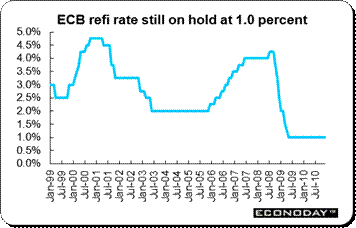 As widely expected the ECB left key interest rates on hold at last Thursday’s council meeting. Accordingly, the deposit rate remains at 0.25 percent, the marginal lending facility rate at 1.75 percent and the key refinancing rate at 1.0 percent. In addition, while reiterating that current non-standard monetary measures would be only temporary, the central bank also announced that the 1-week, 1-month and 3-month repo operations would be undertaken on a fixed rate, full allotment basis until at least the end of the first quarter of next year. This may have disappointed those anticipating an extension of the SMP but remember that just a month ago markets were expecting the ECB to announce a return to some form of competitive bidding as part of its exit strategy. Nonetheless, financial crisis or not the latest policy moves suggest that the ECB is only prepared to go so far. New economic forecasts presented by the central bank showed no significant changes from the September projections. The wide range for the 2011 real GDP forecast (0.7 percent to 2.1 percent) is testimony enough to the high levels of uncertainty over the outlook. As widely expected the ECB left key interest rates on hold at last Thursday’s council meeting. Accordingly, the deposit rate remains at 0.25 percent, the marginal lending facility rate at 1.75 percent and the key refinancing rate at 1.0 percent. In addition, while reiterating that current non-standard monetary measures would be only temporary, the central bank also announced that the 1-week, 1-month and 3-month repo operations would be undertaken on a fixed rate, full allotment basis until at least the end of the first quarter of next year. This may have disappointed those anticipating an extension of the SMP but remember that just a month ago markets were expecting the ECB to announce a return to some form of competitive bidding as part of its exit strategy. Nonetheless, financial crisis or not the latest policy moves suggest that the ECB is only prepared to go so far. New economic forecasts presented by the central bank showed no significant changes from the September projections. The wide range for the 2011 real GDP forecast (0.7 percent to 2.1 percent) is testimony enough to the high levels of uncertainty over the outlook.
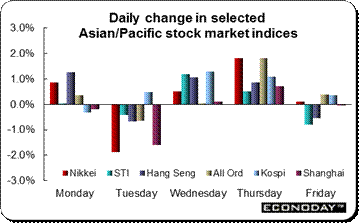 Apart from looking over their shoulder at the ongoing turmoil in the European financial markets, regional shares began the week focused on the next potential move in Chinese monetary policy. As a result, signs that China might be growing even more quickly than thought produced mixed results as the implications of increased PBoC tightening risks vied with the potentially enhanced outlook for export opportunities. However, in the end the ongoing liquidity squeeze ensured that China was the only major market in the region to see shares close lower on the week. Apart from looking over their shoulder at the ongoing turmoil in the European financial markets, regional shares began the week focused on the next potential move in Chinese monetary policy. As a result, signs that China might be growing even more quickly than thought produced mixed results as the implications of increased PBoC tightening risks vied with the potentially enhanced outlook for export opportunities. However, in the end the ongoing liquidity squeeze ensured that China was the only major market in the region to see shares close lower on the week.
A raft of Chinese data on Sunday December 12, probably coinciding with the announcement of the next shift in PBoC policy, should further highlight the underlying buoyancy of the local economy.
 Bearish sentiment towards the euro held intact at the start of last week as confidence in the ability of European policymakers to tackle the sovereign debt crisis waned still further. Losses by the single currency were apparent shortly after European markets opened as capital flows sought the safe haven appeal of the US dollar and the Swiss franc. However, hopes that the ECB might be about to expand its bond buying programme saw the single currency post its largest one-day rise in six weeks on Wednesday. There was also a newswire report, subsequently denied, suggesting that the US would increase its contribution to the IMF as part of a plan to boost a Eurozone stabilization package. Some disappointment with the outcome of the ECB meeting saw the dollar claw back a little ground before Friday and the U.S. unit was trading late in New York only around 0.5 percent lower on the week. Reflecting still elevated levels of uncertainty in financial markets, the Swiss franc gained 2.5 percent over the period with strong third quarter GDP adding to the unit’s appeal. After some early losses, commodity-linked currencies also performed well. The renewed optimism on global demand prospects saw the Australian dollar and Canadian dollar make good headway over the latter half of the period and both posted gains in excess of 2 percent. The Chinese yuan edged fractionally stronger over the week but the Japanese yen and South Korean won both closed up almost 2 percent. Bearish sentiment towards the euro held intact at the start of last week as confidence in the ability of European policymakers to tackle the sovereign debt crisis waned still further. Losses by the single currency were apparent shortly after European markets opened as capital flows sought the safe haven appeal of the US dollar and the Swiss franc. However, hopes that the ECB might be about to expand its bond buying programme saw the single currency post its largest one-day rise in six weeks on Wednesday. There was also a newswire report, subsequently denied, suggesting that the US would increase its contribution to the IMF as part of a plan to boost a Eurozone stabilization package. Some disappointment with the outcome of the ECB meeting saw the dollar claw back a little ground before Friday and the U.S. unit was trading late in New York only around 0.5 percent lower on the week. Reflecting still elevated levels of uncertainty in financial markets, the Swiss franc gained 2.5 percent over the period with strong third quarter GDP adding to the unit’s appeal. After some early losses, commodity-linked currencies also performed well. The renewed optimism on global demand prospects saw the Australian dollar and Canadian dollar make good headway over the latter half of the period and both posted gains in excess of 2 percent. The Chinese yuan edged fractionally stronger over the week but the Japanese yen and South Korean won both closed up almost 2 percent.
Selected currencies — weekly results
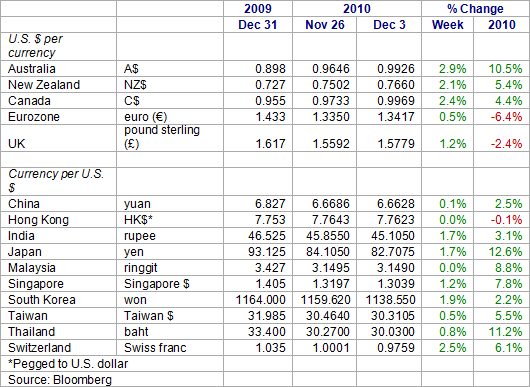
 There were no revisions to the flash estimate of real GDP last quarter. Hence, third quarter total output still shows a 0.4 percent advance over the previous period and an annual growth rate of 1.9 percent. The first look at the expenditure components revealed a modest 0.3 percent quarterly gain in household spending (up from 0.2 percent last time) but only stable fixed capital formation (1.7 percent). At the same time government consumption was 0.4 percent stronger (0.1 percent) but business inventories had no significant impact. Meantime, exports rose 1.9 percent (4.3 percent last time) which, with imports climbing a more modest 1.7 percent (4.2 percent), meant net foreign trade added 0.1 percentage points to the overall quarterly advance, in line with their contribution in the previous period. Much as expected, there were wide regional variations in growth and it is these imbalances that remain a major threat to the stability of Eurozone financial markets going forwards. While Germany (0.7 percent), France (0.4 percent), Finland (1.3 percent) and Austria (0.9 percent) all registered respectable rates of expansion, Greece (minus 0.1 percent), Italy (0.2 percent) and Spain (0.0 percent) all continued to struggle. The Portuguese economy grew 0.4 percent on the quarter but annual growth was still just 1.5 percent. There were no revisions to the flash estimate of real GDP last quarter. Hence, third quarter total output still shows a 0.4 percent advance over the previous period and an annual growth rate of 1.9 percent. The first look at the expenditure components revealed a modest 0.3 percent quarterly gain in household spending (up from 0.2 percent last time) but only stable fixed capital formation (1.7 percent). At the same time government consumption was 0.4 percent stronger (0.1 percent) but business inventories had no significant impact. Meantime, exports rose 1.9 percent (4.3 percent last time) which, with imports climbing a more modest 1.7 percent (4.2 percent), meant net foreign trade added 0.1 percentage points to the overall quarterly advance, in line with their contribution in the previous period. Much as expected, there were wide regional variations in growth and it is these imbalances that remain a major threat to the stability of Eurozone financial markets going forwards. While Germany (0.7 percent), France (0.4 percent), Finland (1.3 percent) and Austria (0.9 percent) all registered respectable rates of expansion, Greece (minus 0.1 percent), Italy (0.2 percent) and Spain (0.0 percent) all continued to struggle. The Portuguese economy grew 0.4 percent on the quarter but annual growth was still just 1.5 percent.
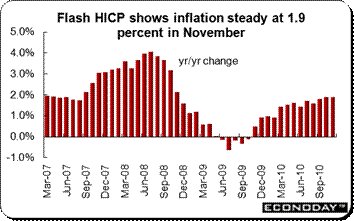 Consumer prices provisionally behaved much as expected this month with the annual HICP inflation rate holding steady at 1.9 percent, just a whisker below the ECB’s target ceiling. As usual Eurostat provided no details behind the headline numbers but from national data it is very clear that the underlying picture remains benign. Regionally there was a surprisingly sharp bounce in the overall German rate, up 0.3 percentage points to 1.6 percent, but inflation slowed in both Italy (1.8 percent from 2.0 percent) and Spain (2.2 percent from 2.3 percent). New EU Commission forecasts put Eurozone inflation at 1.5 percent this year, 1.8 percent in 2011 and 1.7 percent in 2012. Consumer prices provisionally behaved much as expected this month with the annual HICP inflation rate holding steady at 1.9 percent, just a whisker below the ECB’s target ceiling. As usual Eurostat provided no details behind the headline numbers but from national data it is very clear that the underlying picture remains benign. Regionally there was a surprisingly sharp bounce in the overall German rate, up 0.3 percentage points to 1.6 percent, but inflation slowed in both Italy (1.8 percent from 2.0 percent) and Spain (2.2 percent from 2.3 percent). New EU Commission forecasts put Eurozone inflation at 1.5 percent this year, 1.8 percent in 2011 and 1.7 percent in 2012.
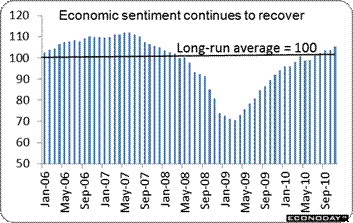 Economic sentiment was a little stronger than expected last month according to the EU Commission's latest survey. At 105.3, the headline index rose 1.5 points from a slightly weaker revised level in October and now stands nearly 35 points above the record low seen in March 2009. November's advance was attributable to modest gains in industrial confidence (0.9 points to 0.9), consumer morale (1.5 points to minus 9.4) and a more marked increase in sentiment in services (2.1 points to 10.2). However, the retail sector weakened somewhat (minus 1.5 from minus 1.1) as did construction (minus 26.4 from minus 25.4). Regionally there was another solid gain in sentiment in Germany (2.8 points to 116.3) and not so impressive rises in Italy (1.4 points to 98.5) and Spain (0.3 points to 90.8). Less promisingly, morale slipped in France (104.9 from 105.1). Elsewhere, sentiment declined in Greece (0.3 points to just 67.0) and in Portugal (2.2 points to 88.5). Economic sentiment was a little stronger than expected last month according to the EU Commission's latest survey. At 105.3, the headline index rose 1.5 points from a slightly weaker revised level in October and now stands nearly 35 points above the record low seen in March 2009. November's advance was attributable to modest gains in industrial confidence (0.9 points to 0.9), consumer morale (1.5 points to minus 9.4) and a more marked increase in sentiment in services (2.1 points to 10.2). However, the retail sector weakened somewhat (minus 1.5 from minus 1.1) as did construction (minus 26.4 from minus 25.4). Regionally there was another solid gain in sentiment in Germany (2.8 points to 116.3) and not so impressive rises in Italy (1.4 points to 98.5) and Spain (0.3 points to 90.8). Less promisingly, morale slipped in France (104.9 from 105.1). Elsewhere, sentiment declined in Greece (0.3 points to just 67.0) and in Portugal (2.2 points to 88.5).
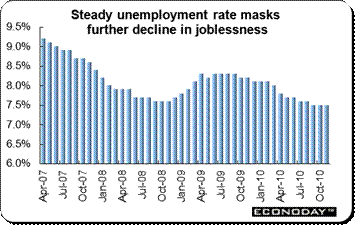 The labour market continued to improve in November, albeit with a smaller than expected 9,000 decline in the number of people out of work. Unemployment now stands at 3.144 million. The latest fall, which followed an unrevised 3,000 drop at the start of the quarter, left the jobless rate unchanged at 7.5 percent. Although recent months have seen a sharp reduction in the pace at which unemployment has fallen, in general the jobs market remains in good shape. Hence, the lagging payroll data showed a solid 34,000 advance in October and vacancies in November rose another 10,000. Indeed, business surveys suggest that a wide range of companies are planning to add to headcount over coming months and just last week, the Economics Ministry suggested that full employment was possible soon. If so, and in contrast to much of Europe, labour shortages rather than excess capacity could become a problem for policymakers further out. The labour market continued to improve in November, albeit with a smaller than expected 9,000 decline in the number of people out of work. Unemployment now stands at 3.144 million. The latest fall, which followed an unrevised 3,000 drop at the start of the quarter, left the jobless rate unchanged at 7.5 percent. Although recent months have seen a sharp reduction in the pace at which unemployment has fallen, in general the jobs market remains in good shape. Hence, the lagging payroll data showed a solid 34,000 advance in October and vacancies in November rose another 10,000. Indeed, business surveys suggest that a wide range of companies are planning to add to headcount over coming months and just last week, the Economics Ministry suggested that full employment was possible soon. If so, and in contrast to much of Europe, labour shortages rather than excess capacity could become a problem for policymakers further out.
 Retail sales bounced back sharply in October following successive declines in August and September. Indeed, volumes excluding autos were up a larger than expected 2.3 percent on the month and so more than reversed a revised 1.8 percent fall at the end of last quarter. Sales are now back at the level last seen in July. The October gain still left unadjusted purchases down 0.7 percent on the year but, more significantly, compared with their third quarter average they were 0.9 percent higher. The limited disaggregated data show a 2.4 percent annual drop in the food, drink and tobacco sector and a 0.5 percent rise in non-food buying. Furniture and household items (1.7 percent) and the other assorted goods category (1.8 percent) held up relatively well but there was a steep decline in mail order (2.4 percent). The bounce-back at the start of the quarter bodes well for overall consumer spending in the run-up to Christmas and is consistent with the optimism shown by retailers in recent surveys. In fact, should November and December see further improvement, the self-sustainability of the German economic recovery would take a major leap forward. Retail sales bounced back sharply in October following successive declines in August and September. Indeed, volumes excluding autos were up a larger than expected 2.3 percent on the month and so more than reversed a revised 1.8 percent fall at the end of last quarter. Sales are now back at the level last seen in July. The October gain still left unadjusted purchases down 0.7 percent on the year but, more significantly, compared with their third quarter average they were 0.9 percent higher. The limited disaggregated data show a 2.4 percent annual drop in the food, drink and tobacco sector and a 0.5 percent rise in non-food buying. Furniture and household items (1.7 percent) and the other assorted goods category (1.8 percent) held up relatively well but there was a steep decline in mail order (2.4 percent). The bounce-back at the start of the quarter bodes well for overall consumer spending in the run-up to Christmas and is consistent with the optimism shown by retailers in recent surveys. In fact, should November and December see further improvement, the self-sustainability of the German economic recovery would take a major leap forward.
 The quarterly jobless data showed unemployment holding steady on the mainland at 9.3 percent in the period just ended. The stability here was mirrored in the total figure (9.7 percent) which includes overseas territories. Chances are that the labour market is now over the worst but a return to pre-crisis levels is still likely some way off with the full impact of fiscal tightening yet to be fully realized. Still, with the real economy amongst the best performers in the region, employment prospects in France are probably rather better than in many of its EMU neighbours. Jobless claims in October pointed to a slight increase in payrolls at the start of the fourth quarter. The quarterly jobless data showed unemployment holding steady on the mainland at 9.3 percent in the period just ended. The stability here was mirrored in the total figure (9.7 percent) which includes overseas territories. Chances are that the labour market is now over the worst but a return to pre-crisis levels is still likely some way off with the full impact of fiscal tightening yet to be fully realized. Still, with the real economy amongst the best performers in the region, employment prospects in France are probably rather better than in many of its EMU neighbours. Jobless claims in October pointed to a slight increase in payrolls at the start of the fourth quarter.
 Producer prices (excluding construction) rose for the fifth month in succession in October. A surprisingly steep 0.8 percent rise on the month saw annual PPI inflation accelerate from 4.2 percent to 4.3 percent, its fastest rate since October 2008. However, once again it was energy prices that did the bulk of the damage with the price of heating oil up 3.6 percent from September and diesel oil costs 2.5 percent stronger. Coke and refined petroleum products stood nearly 26 percent higher on the year. This compares with 12-month inflation rates in the consumer sector of just 0.5 percent and in capital goods of only 0.9 percent. Underlying trends continue soft. Producer prices (excluding construction) rose for the fifth month in succession in October. A surprisingly steep 0.8 percent rise on the month saw annual PPI inflation accelerate from 4.2 percent to 4.3 percent, its fastest rate since October 2008. However, once again it was energy prices that did the bulk of the damage with the price of heating oil up 3.6 percent from September and diesel oil costs 2.5 percent stronger. Coke and refined petroleum products stood nearly 26 percent higher on the year. This compares with 12-month inflation rates in the consumer sector of just 0.5 percent and in capital goods of only 0.9 percent. Underlying trends continue soft.
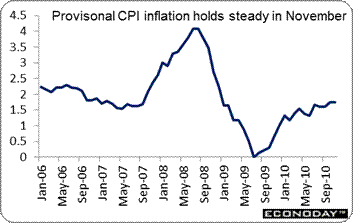 November consumer prices were provisionally a little softer than expected. The CPI was unchanged from its October level which in turn left the annual inflation rate steady at 1.7 percent, a tick lower than market forecasts. Harmonised prices were even better behaved, registering a 0.1 percent monthly fall that shaved 0.2 percentage points off October's annual pace to 1.8 percent. Once again there was little change in underlying price developments with the core CPI up 1.5 percent on the year, matching the start of quarter outcome. As usual, the main upward pressure on the annual rate came from the energy market although prices also rose significantly more steeply in leisure and culture. By contrast the 12-month inflation rate fell sharply in hotels, cafes and restaurants. November consumer prices were provisionally a little softer than expected. The CPI was unchanged from its October level which in turn left the annual inflation rate steady at 1.7 percent, a tick lower than market forecasts. Harmonised prices were even better behaved, registering a 0.1 percent monthly fall that shaved 0.2 percentage points off October's annual pace to 1.8 percent. Once again there was little change in underlying price developments with the core CPI up 1.5 percent on the year, matching the start of quarter outcome. As usual, the main upward pressure on the annual rate came from the energy market although prices also rose significantly more steeply in leisure and culture. By contrast the 12-month inflation rate fell sharply in hotels, cafes and restaurants.
The manufacturing sector enjoyed a surprisingly good month in November according to the latest purchasing managers' survey. At 58.0, the headline PMI was up nearly 3 points from a higher revised October level to register its best reading since September 1994. Output rose at its fastest pace since May, reflecting improvements in both domestic and overseas demand. New orders posted their strongest performance since April, backlogs were up for the first time in five months and outstanding business continued to gain ground. However, the most eye-catching news concerned employment which grew at the most rapid pace in the survey's history. Staffing levels have now increased in each of the last eight months. However, the good news on the real economy was tempered by indications of a further pick-up in cost pressures. Hence, input prices accelerated to their fastest pace since August 2008 and factory gate prices rose for the 13th month running. At least the BoE may take some solace from the fact that output charges increased at their slowest rate in eight months, but even this was above the average for the period. Having seen manufacturing output expand 1 percent on the period in the quarter just ended, the November PMI suggests that the goods producing sector will make another useful contribution to real GDP growth in the current quarter. This will come as no little relief to the BoE but the inflation content of the November survey will leave many MPC members all the more concerned about meeting the 2 percent inflation target.
 Household spending fell 0.4 percent on the year in October, its first annual decline in five months. The decline was prompted by the end of the government’s subsidy programme for purchases of energy-efficient vehicles in early September. Spending on autos dropped 5.9 percent, compounding a 1.7 percent slide in September. In August auto consumption was up fully 8.6 percent as buyers moved to make the most of the subsidy. Household spending fell 0.4 percent on the year in October, its first annual decline in five months. The decline was prompted by the end of the government’s subsidy programme for purchases of energy-efficient vehicles in early September. Spending on autos dropped 5.9 percent, compounding a 1.7 percent slide in September. In August auto consumption was up fully 8.6 percent as buyers moved to make the most of the subsidy.
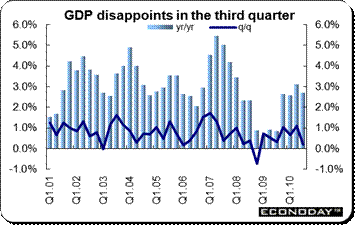 Economic growth slowed surprisingly sharply in the third quarter when real GDP expanded just 0.2 percent on the previous period, its worst performance since a contraction at the end of 2008. The modest increase followed a 1.1 percent rate in the second quarter, but favourable base effects saw the annual increase in total output hold steady at 2.7 percent. In practice the quarterly headline rate is misleadingly soft since net exports subtracted some 0.4 percentage points; indeed final consumption expenditures rose 0.6 percent and contributed 0.3 percentage points to the quarterly advance. There was also a 0.9 percent gain in gross fixed private capital formation. Bad weather was almost certainly responsible in part for the poor figures and the government remains convinced that its 3.5 percent growth forecast for next year will be achieved. Still, with retail sales down a surprising 1.1 percent on the month in October, markets have become more skeptical of another early move on RBA interest rates. Economic growth slowed surprisingly sharply in the third quarter when real GDP expanded just 0.2 percent on the previous period, its worst performance since a contraction at the end of 2008. The modest increase followed a 1.1 percent rate in the second quarter, but favourable base effects saw the annual increase in total output hold steady at 2.7 percent. In practice the quarterly headline rate is misleadingly soft since net exports subtracted some 0.4 percentage points; indeed final consumption expenditures rose 0.6 percent and contributed 0.3 percentage points to the quarterly advance. There was also a 0.9 percent gain in gross fixed private capital formation. Bad weather was almost certainly responsible in part for the poor figures and the government remains convinced that its 3.5 percent growth forecast for next year will be achieved. Still, with retail sales down a surprising 1.1 percent on the month in October, markets have become more skeptical of another early move on RBA interest rates.
 The November manufacturing PMI pointed to a further acceleration in economic activity last month. At 55.2, the headline index rose 0.5 points from its October level for the fourth monthly increase in a row. Amongst the sub-components output was particularly strong, up 1.4 points to 58.5, while new orders edged up 0.1 points to 58.3. However, in the context of ongoing inflationary concerns, of most significance was a nearly 4 point gain in the input price index to 73.6. The surge here translated into a series record rise in output prices which can only bode ill for future inflation in the consumer sector. The November manufacturing PMI pointed to a further acceleration in economic activity last month. At 55.2, the headline index rose 0.5 points from its October level for the fourth monthly increase in a row. Amongst the sub-components output was particularly strong, up 1.4 points to 58.5, while new orders edged up 0.1 points to 58.3. However, in the context of ongoing inflationary concerns, of most significance was a nearly 4 point gain in the input price index to 73.6. The surge here translated into a series record rise in output prices which can only bode ill for future inflation in the consumer sector.
 Economic growth again slowed last quarter. A 0.3 percent rise in real GDP on the previous period was only half the rate achieved in the second quarter although annual growth actually held steady at 3.4 percent. The deceleration reflected a sharp deterioration in the real current account where export volumes shrank 1.3 percent on the quarter and imports rose 1.6 percent. In fact final domestic demand actually matched the 0.9 percent pace seen in the previous period. Consumer spending was up 0.9 percent after a subdued 0.6 percent increase last time and gross fixed capital formation expanded 1.9 percent, again in line with its second quarter performance. Government spending increased just 0.2 percent following a 0.7 percent gain previously. Economic growth again slowed last quarter. A 0.3 percent rise in real GDP on the previous period was only half the rate achieved in the second quarter although annual growth actually held steady at 3.4 percent. The deceleration reflected a sharp deterioration in the real current account where export volumes shrank 1.3 percent on the quarter and imports rose 1.6 percent. In fact final domestic demand actually matched the 0.9 percent pace seen in the previous period. Consumer spending was up 0.9 percent after a subdued 0.6 percent increase last time and gross fixed capital formation expanded 1.9 percent, again in line with its second quarter performance. Government spending increased just 0.2 percent following a 0.7 percent gain previously.
 The Canadian labour market data sent out superficially strong signals last month as a much as expected 15,200 increase in employment combined with a surprisingly steep 0.3 percentage point fall to 7.6 percent in the jobless rate. However, the rise in headline employment reflected a 26,700 jump in part-time positions and masked an 11,500 decline in full-time work. Moreover, private sector payrolls were down 11,500. Meantime, the slide in the unemployment rate was essentially attributable to a 43,600 fall in the labour force and 0.3 percentage point drop in the participation rate. The service sector fully accounted for November's employment gain, posting a 36,200 increase that was partially offset by a 21,000 drop in headcount in the goods producing sector. Services trade saw a solid 26,200 rise and health care and social assistance was up 28,400. Transport and warehousing payrolls climbed 10,900 and accommodation and food services created a net 16,600 new positions. However, advances here were in part mitigated by a near-23,000 slump in finance, insurance, real estate and leasing together with an 11,100 slide in public administration. In the goods producing sector employment in manufacturing declined almost 29,000 and utilities were down 4,100. Agriculture (3,900), construction (6,600) and natural resources (1,300) all saw small gains. The bottom line to the survey is that that while the headline figures look impressive, they conceal further evidence that the Canadian economy is slowing. The BoC is all the more likely to keep rates on hold for an extended period in the wake of this report. The Canadian labour market data sent out superficially strong signals last month as a much as expected 15,200 increase in employment combined with a surprisingly steep 0.3 percentage point fall to 7.6 percent in the jobless rate. However, the rise in headline employment reflected a 26,700 jump in part-time positions and masked an 11,500 decline in full-time work. Moreover, private sector payrolls were down 11,500. Meantime, the slide in the unemployment rate was essentially attributable to a 43,600 fall in the labour force and 0.3 percentage point drop in the participation rate. The service sector fully accounted for November's employment gain, posting a 36,200 increase that was partially offset by a 21,000 drop in headcount in the goods producing sector. Services trade saw a solid 26,200 rise and health care and social assistance was up 28,400. Transport and warehousing payrolls climbed 10,900 and accommodation and food services created a net 16,600 new positions. However, advances here were in part mitigated by a near-23,000 slump in finance, insurance, real estate and leasing together with an 11,100 slide in public administration. In the goods producing sector employment in manufacturing declined almost 29,000 and utilities were down 4,100. Agriculture (3,900), construction (6,600) and natural resources (1,300) all saw small gains. The bottom line to the survey is that that while the headline figures look impressive, they conceal further evidence that the Canadian economy is slowing. The BoC is all the more likely to keep rates on hold for an extended period in the wake of this report.
It remains to be seen whether the shift in investor sentiment last week from risk aversion to something approaching risk appetite is sustainable or just a temporary kneejerk reaction to good economic data and over-sold markets. Certainly the Eurozone debt crisis is far from resolved, the U.S. economic outlook is still highly uncertain and China should soon be announcing another monetary tightening. Against this backdrop, upcoming news will probably need to be positive if financial markets are to enjoy the run-up to Christmas.
This week’s calendar is dominated by central bank policy announcements in Australia, New Zealand, the UK, Canada and, potentially, China. The ECB will release its latest monthly bulletin and in Japan the BoJ will provide its new quarterly Tankan survey. Upcoming economic data will be dominated by October industrial production in a number of EU countries, the November labour market survey in Australia and November CPI, industrial production and retail sales in China. Japan will issue its revised third quarter GDP report. The U.S. calendar is light, but Canada sees the November PMI and October merchandise trade.
| Central Bank activities |
|
| December 7 |
Australia |
Reserve Bank of Australia Announcement |
|
Canada |
Bank of Canada Announcement |
| December 9 |
New Zealand |
Reserve Bank of New Zealand Announcement |
|
UK |
Bank of England Announcement |
|
EMU |
ECB Releases Monthly Bulletin |
| December 10-12 |
China |
Central Economic Work Meeting (tentative) |
| The following indicators will be released this week... |
| Europe |
|
|
| December 7 |
UK |
Industrial Production (October) |
|
Germany |
Manufacturing Orders (October) |
| December 8 |
Germany |
Merchandise Trade (October) |
|
|
Industrial Production (October) |
| December 9 |
Germany |
CPI (November final) |
|
UK |
Merchandise Trade Balance (October) |
| December 10 |
France |
Industrial Production (October) |
|
Italy |
Industrial Production (October) |
|
|
Gross Domestic Product (Q3.2010 revised) |
|
UK |
PPI (November) |
| Asia/Pacific |
|
|
| December 8 |
Japan |
GDP (Q3.2010) |
|
Australia |
Labour Force Survey (November) |
|
|
Retail Sales (November) |
| December 9 |
China |
Merchandise Trade Balance (November) |
| December 10 |
Japan |
Tankan Survey (Q4.2010) |
|
|
Tertiary Activity Index (October) |
| December 12 |
China |
CPI (November) |
|
|
Industrial Production (November) |
|
|
PPI (November) |
|
|
Retail Sales (November) |
| Americas |
|
|
| December 6 |
Canada |
Manufacturing PMI (November) |
| December 10 |
Canada |
Merchandise Trade Balance (October) |
|
Canada |
International Trade (October) |
|

